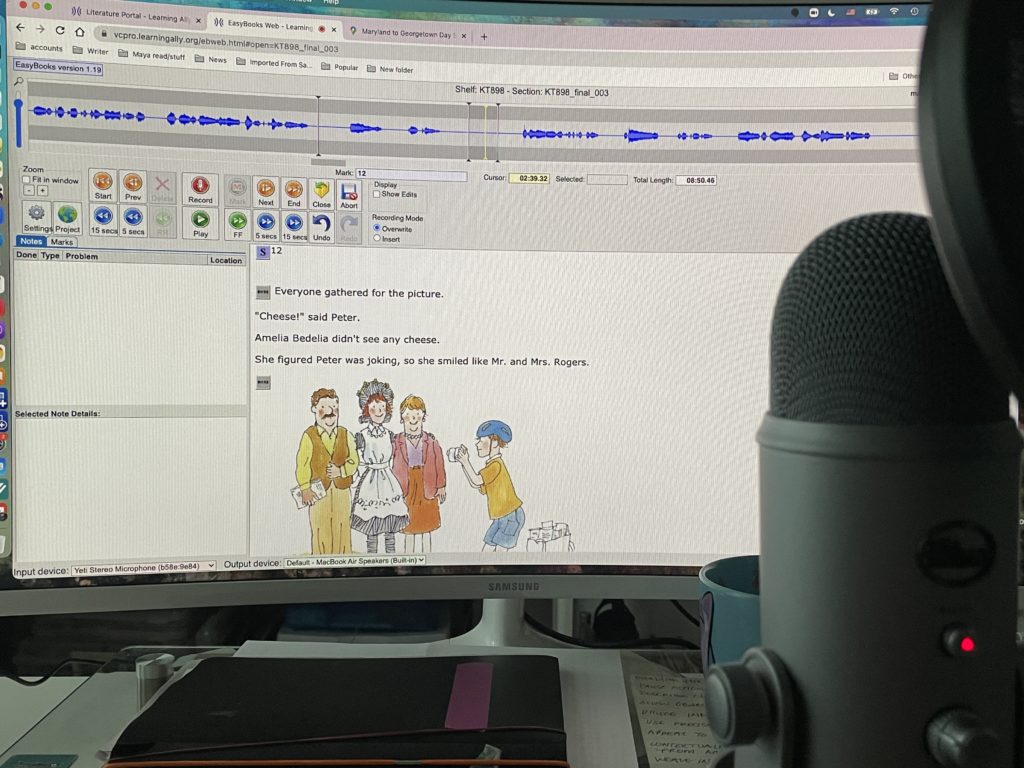Ponderings of an audiobook narrator.
Audiobooks have become a staple for book lovers, especially those who commute, multi-task, or have difficulty reading. Audiobooks are also a strategic educational tool. How? Read on to find out why I am an audiobook narrator, how audiobooks make a difference to students who struggle with reading, and what is involved in creating these integrated tools to facilitate learning for students and help them reach their potential.

I have volunteered as an audiobook narrator with Learning Ally for almost a decade. Learning Ally is a nonprofit organization that provides solutions for students from Pre-K through high school.
Although philanthropic work is often seen as selfless endeavour, I admit I narrate for several selfish reasons. First, it gives me a reason to read. Why do I need a reason to read beyond simple pleasure? I don’t, but it helps justify the time I spend with books. Secondly, this activity also allows me to share my love of books with others.
Finally, reading aloud taps into other aspects of processing words and language, which is very satisfying for me as a reader and writer. In the same way that reading in my head and reading out loud allows me to process words and language differently, students who struggle to read may find that reading, listening, and interacting with a book helps them process the information more effectively.
The audiobooks through Learning Ally differ from standard audiobooks in that they are designed as a support tool for the students. This provides interactive features which are especially important for younger students, and includes complete text to allow the visual experiencing of the words, as well as control of the audio and visual experience with highlighting and speed management.
Speaking of speed, just how long does it take to create an audiobook? Mike Kinsey, Lead Recruiter for Voice Talent, has been involved in the technical and production aspects of Learning Ally for over two decades. According to his estimates, while it might take an average of ten hours to listen to an unabridged novel of about 330-350 pages, the making of an audiobook can take 30-60 hours to get from narration through post-production to the student.
Although I can’t address the technical aspects, I know that, as a narrator, reading aloud isn’t as easy at it might seem — even with children’s books and sentences that look simple. Reading out loud involves interpreting the author’s intent and expressing the emotion within those words. Also, effective narration requires different character voices and switching in and out of the narrator’s voice. i.e. “Let go of my bag,” Maya said. She tugged the leather strap so hard it it snapped, slapping her in the face. “Ouch.”
The length of the audiobook can also vary spending on how complex and atmospheric the book is, and the pace of the book. Another curious thing that happens when you read out loud is that your brain can fix errors. For example, in the above sentence, there is an extra ‘it’ in the sentence. Your brain may delete one ‘it’ as you read, but, as it gets tired, it may also mix up and substitute other words.
That’s where listeners have to quality check the original narration and send back a list of any required edits to the narrator, as well as mistakes in the written portion of the book, such as the second ‘it’. I am often surprised how my brain rewrites the text and I read a word from a line two lines ahead or might substitute ‘slapping’ for ‘smacking.’ Also, it can take several attempts to read a sentence without errors such as mispronunciation of words, swallowing letters, misplaced emphasis in a word or sentence and incorrect modulations. These are all reasons a ten hour listening experience may take three or four times longer to create, and why there are about twenty staff members and at least three volunteers involved in the entire process.
So, there’s a lot more involved to this sort of book production than the love of reading and some equipment (I have a really simple set up using a Yeti microphone and a pop filter). It requires the love of reading out loud, acting (thankfully, in the privacy of your own home), patience, commitment and the quiet reward of helping people you may never hear from or meet.
Learning Ally produces about one hundred books a month and their target audience is grades two to eight to promote early literacy. Last year 1.5 million students had access to the solutions provided by Learning Ally. While there are a few hundred active volunteers with Learning Ally, their database holds 6,000 volunteers that have worked with them and who sign on for special projects – for example, with foreign language books. For further information about their services, you can check out the Learning Ally website.
Do you use or narrate audiobooks? Who are your favourite narrators and why? What equipment do you use? Please leave me a comment and let me know.
Pingback: Ten books for the ebb and flow of a writer's life. - Maya Fleischmann
Excellent